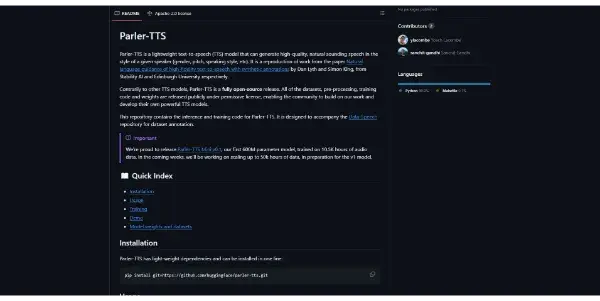Parler-TTS

An open-source AI tool that generates natural voices from text using a model with 600 million parameters. Create your own voice
Parler-TTS: A Deep Dive into Open-Source Text-to-Speech with Voice Cloning Capabilities
Parler-TTS is a groundbreaking open-source AI tool that leverages a sophisticated 600-million parameter model to generate remarkably natural-sounding speech from text input. Its key differentiator lies in its ability to not only synthesize speech but also to offer a degree of voice cloning, allowing users to create digital representations of their own voices. This article explores its functionality, benefits, applications, and how it stacks up against competitors.
What Parler-TTS Does
Parler-TTS takes text as input and transforms it into high-quality, natural-sounding audio. Unlike simpler TTS systems, its large model size enables it to produce speech with nuanced intonation, phrasing, and emotional inflection, moving beyond monotone robotic voices. The core functionality includes:
- Text-to-Speech Synthesis: Convert written text into spoken audio.
- Voice Cloning (Partial): While not a full-fledged voice cloning system in the sense of perfectly replicating a voice from a short sample, Parler-TTS offers the potential to create a synthesized voice that closely resembles the user's voice based on provided training data. This is a significant advantage over many other open-source solutions.
Main Features and Benefits
- High-Quality Audio: The 600-million parameter model ensures a significant improvement in audio quality compared to smaller models. The resulting speech is significantly more natural and less robotic.
- Open-Source and Free: The project is hosted on GitHub, fostering community contribution and ensuring accessibility for everyone. The tool is entirely free to use.
- Potential for Voice Cloning: The ability to partially clone a user's voice opens up exciting possibilities for personalized applications and accessibility tools.
- Customizability: While requiring technical expertise, users can potentially fine-tune the model to achieve even greater control over the synthesized speech characteristics.
- Extensibility: The open-source nature allows for integration with other projects and applications.
Use Cases and Applications
Parler-TTS has a wide range of potential applications across various industries:
- Accessibility: Creating audio versions of text for visually impaired individuals.
- E-learning: Generating voiceovers for educational videos and content.
- Gaming: Developing immersive gaming experiences with realistic voice interactions.
- Content Creation: Producing voiceovers for videos, podcasts, and audiobooks.
- Assistive Technologies: Powering voice assistants and other assistive technologies tailored to individual needs.
- Personalized Voice Assistants: Developing custom voice assistants with a user's own voice.
Comparison to Similar Tools
Parler-TTS distinguishes itself from other open-source TTS tools primarily through its size and resulting audio quality. While many open-source options exist, few offer the same level of naturalness and the potential for voice cloning. Commercial solutions often provide superior cloning capabilities, but at a significant cost. Parler-TTS provides a compelling middle ground, offering a balance between quality, openness, and cost. A direct comparison would require benchmarking against specific competitors like VITS or other commercially available options on factors like naturalness, expressiveness, and ease of use.
Pricing Information
Parler-TTS is entirely free to use. There are no licensing fees or subscription costs associated with the software. However, users will need to manage their own computational resources for training and inference.
Conclusion
Parler-TTS represents a significant advancement in open-source text-to-speech technology. Its high-quality audio output, potential for voice cloning, and open-source nature make it a valuable tool for developers and researchers alike. While it may require some technical expertise to utilize effectively, its potential applications are vast and its free availability makes it an attractive option for a wide range of users. Future development and community contributions will likely further enhance its capabilities and broaden its applicability.